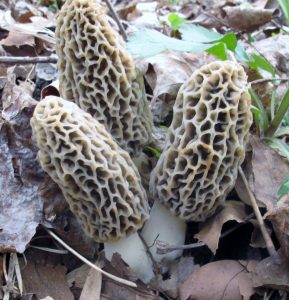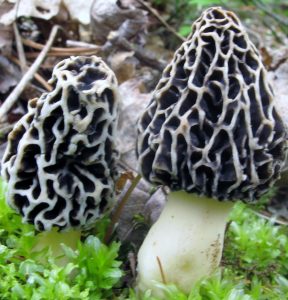
EAST PALESTINE, Ohio — Mushrooms often get a bad reputation based on folklore, superstitions and even mythical beliefs cultures have passed down from one generation to the next.
Walt Sturgeon, Columbiana County’s resident mushroom expert, has been setting the record straight and educating about mushrooms for four decades.
“There is only one native mushroom to Ohio that is a hallucinogen. Most of the recreational mushrooms are imported from other countries,” he said, but agrees that mushrooms and “mushroom people” are often misunderstood.
Known across the nation as the mushroom guru, Sturgeon lives for the next mushroom season.
He travels to speaking engagements and serves as the mushroom expert for many mushroom hunts or forays, but his favorite part of the season is when he gets out in the woods to do his own hunting.
“I enjoy the element of ‘find and discover’ the hunt allows,” said Sturgeon, who lives in East Palestine, Ohio, with his wife, Trish. For him, the thrill of a mushroom hunt is like a child hunting Easter eggs.
Getting started
Sturgeon first started collecting mushrooms in his 20s, influenced by his father who also collected mushrooms. His first mushroom book was a coffee table book of mushrooms from Europe, but he quickly learned that was useless, as the varieties in Europe are much different than those in Ohio.

Not discouraged, the next Christmas he received an identification book and found the Ohio Mushroom Society and jumped in head first.
About six months into his research Sturgeon went to a big foray, where mushroom enthusiasts find and identify mushrooms. The experience piqued his interest and he was hooked.
Photos
Sturgeon has taken thousands of pictures of mushrooms, and uses his photos in educational resources he has created and for his own identification library.
When he finds a new fungus, he will take notes, write his own description and photograph it.
He has been honored for his documentation with awards such as the North American Mycological Association Award for Contributions to Amateur Mycology, and Northeast Mycological Federation Eximia Award, both for contributions to the advancement of amateur mycology.
Sturgeon frequents a dynamic mushroom identification site, www.mushroomobserver.org. On this site, you can upload a photo of a mushroom and other mushroom identifiers will assist in classifying it. This site facilitates collaboration from around the world.
Research
Sturgeon is an expert in mycology, the scientific study of fungi, from Canada and anywhere east of the Mississippi. Once you get west of the Mississippi River, the varieties are so different, he said, he could get the family right, but that is about it.
Sturgeon works with several universities, sending macrofungi or microfungi he finds to scientists to examine. Some mushrooms are parasitic to trees and others are beneficial.
“The relationship between mushrooms and other organisms is fascinating,” Sturgeon said, a retired social worker.
Morels are mycorrhizal mushrooms, meaning they form a symbiotic relationship with many types of trees, including elms.
In a symbiotic relationship, both life forms benefit from the partnership. The underground, unseen part of the mushroom connects with the root hairs of the tree, said Sturgeon.
The tree provides food, such as sugar manufactured in its leaves, and water. In return, the mycelium, or the vegetative part of the mushroom, supplies nitrogen, phosphorus, potassium and other minerals that improves tree growth.
Walt Sturgeon speaking events
July 8 Beaver Creek Wildlife Center, 9 a.m.-noon
Aug. 27 Scenic Vista Park, Mini Foray, 2-4 p.m.
Oct. 14 Hellbender Bluff, a members’ event or one can join there. No charge for students. RSVP to Walt, 330-426-9833
Major Forays
Members only or join at the event for $15, students free
July 15-16 Lake Hope State Park
Sept. 23-24 Camp Asbury
Three morel hunts planned dates will be posted www.ohiomushroom.org.
For additional information about Sturgeon’s appearances, email mycowalt@comcast.net.
Sturgeon estimates 95 percent of trees benefit from a fungus partner.
Research shows that mushrooms have instincts, too. They can sense if a tree needs help and send out more shoots to assist in a beneficial relationship, he said.
Science and research in mycology is primitive, said Sturgeon. Because it is a fruit, the reproductive part of the organism, it doesn’t last long and the time to do research trials is limited.
Edible
Because mushrooms come and go quickly, mushroom hunters are often obsessed during the short season, constantly on the hunt.
“Many in the U.S. don’t eat mushrooms,” said Sturgeon, “but different cultures around the world used and still use them as a staple in their diet.”
Sturgeon estimates 30 to 40 percent of mushrooms are poisonous, but not deadly, and 40 percent are too small or too tough, leaving just a few varieties that are good for eating.
The “white angel” mushroom has caused more deaths than any other, Sturgeon said. He knows of a case where someone spent 13 days in intensive care from consuming one.
“There is no chemical test to tell if a mushroom is poisonous,” said Sturgeon. With his experience, he knows by examining a new specimen what mushrooms it is related to, and can have a pretty good idea if it would be safe to eat.
Books
He has authored books and resources, and his photos of fungi, some award-winning, can be seen in numerous mushroom field guide publications, two of which he coauthored: Waxcap Mushrooms of Eastern North America and Mushrooms and Macrofungi of Ohio and the Midwestern States.
He has also written Mushrooms and Other Fungi of the West Virginia High Country, and Mushrooms of the Northeast, which was recognized as best field guide of 2016.
Sturgeon is involved in the Ohio Mushroom Society, and you can find more of his writings, mushroom events and recipes at www.ohiomushroom.org.
Morels vs. False Morels


Finding
- Soil should be not too acidic
- Temperature of soil should be around 53 degrees
- End of March through first of May; morel’s usually have about a three-week window.
- Dead elms that still have bark or old orchards are often morel magnets.
- Ground that has been burned or fertilized with ashes or cinders.
- Pick morels that are firm, dry and fresh.
- Don’t pick morels that are soft, wet or spongy.
- Do not collect or store morels in plastic bags — morels spoil rapidly in plastic. Baskets or mesh bags are best for collecting; paper sacks are best for storing in a refrigerator
Cooking
Always cook wild mushrooms; none are safe to eat raw.
1. Soak in water with a dash of salt for 15 minutes, repeat;
2. Cut vertically, they could have a critter inside
3. Pat mushrooms dry
4. Toss in flour
5. Fry in oil or butter until slightly crisp
*Don’t overdo spices or flavorings, let the mushroom flavor come out.
For more mushroom recipes visit www.ohiomushroom.org.











Thanks for this, Katy! Walt is THE MAN for mushrooms and fungi. He’s got experience, scholarship, and enthusiasm.
Great to know he’s a “local.”
Keep it up, Walt; we appreciate all you do!